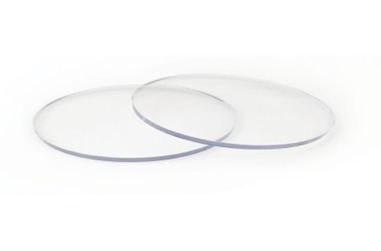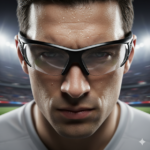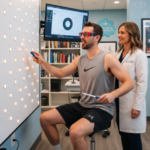Introduction:- In the world of sports, visual performance and eye protection go hand in hand. Whether it’s cricket, football, basketball, cycling, or shooting, athletes depend heavily on their vision for coordination, timing, and spatial judgment. Unfortunately, sports-related eye injuries are common and often preventable. The use of appropriate sports safety glasses plays a vital role in preventing these injuries. Among the different materials used for safety eyewear, polycarbonate lenses have gained immense popularity due to their superior impact resistance, lightweight nature, and optical clarity. In the world of sports, visual performance and eye protection go hand in hand. Whether it’s cricket, football, basketball, cycling, or shooting, athletes depend heavily on their vision for coordination, timing, and spatial judgment. Unfortunately, sports-related eye injuries are common and often preventable. The use of appropriate sports safety glasses plays a vital role in preventing these injuries. Among the different materials used for safety eyewear, polycarbonate lenses have gained immense popularity due to their superior impact resistance, lightweight nature, and optical clarity.
Need for Eye Protection in Sports
Eye injuries in sports can range from minor irritations to serious trauma leading to partial or permanent vision loss. Some common injuries include corneal abrasions, hyphema, orbital fractures, and retinal detachment. Sports such as squash, badminton, baseball, hockey, and cricket involve high-speed balls or projectiles that pose a major risk to the eyes. Contact sports also carry a risk of finger or elbow impact to the face.
Studies suggest that over 90% of sports-related eye injuries can be prevented by using proper protective eyewear. Hence, using safety glasses with impact-resistant lenses like polycarbonate has become a standard recommendation by optometrists and sports vision specialists.
Lens Materials for Sports Safety Glasses
Various lens materials are used for sports eyewear, such as:
Crown Glass
CR-39 Plastic
Trivex
Polycarbonate
Among these, polycarbonate and Trivex are the most preferred for sports applications due to their superior safety characteristics. However, polycarbonate remains the most widely used material worldwide.
What is Polycarbonate?
Polycarbonate is a thermoplastic polymer discovered in the 1950s. It was initially developed for aerospace applications, including visors for astronauts and windows for aircraft. Due to its remarkable strength, clarity, and lightness, it was soon adapted for optical use. It is made through a chemical process involving bisphenol A (BPA) and phosgene, producing a clear and durable plastic material. Polycarbonate is also used in making CDs, bulletproof glass, helmets, and medical devices — showcasing its strength and versatility.
Optical and Physical Properties of Polycarbonate Lenses
Property Polycarbonate Lens
Refractive Index 1.586
Specific Gravity 1.20 (Lightweight)
Abbe Value 30 (moderate chromatic aberration)
Impact Resistance 10 times more than CR-39
UV Protection 100% up to 400 nm
Scratch Resistance Moderate (requires hard coating)
Tensile Strength Very High
Heat Resistance Moderate
Advantages of Polycarbonate Lenses in Sports Safety Glasses
• High Impact Resistance:
Polycarbonate lenses are virtually unbreakable under normal sporting conditions. They can withstand the impact of a ball traveling at over 150 km/h, making them ideal for high-velocity sports.
• Lightweight Comfort:
Being lighter than glass and CR-39 lenses, they reduce pressure on the nose and ears, ensuring comfort during long hours of play.
• UV Protection:
Polycarbonate lenses inherently block 100% of harmful UVA and UVB rays, protecting the eyes from photochemical damage during outdoor sports.
• Thin and Aesthetic:
Due to their higher refractive index, polycarbonate lenses can be made thinner, maintaining a sleek and stylish appearance even for higher prescriptions.
• Durability and Safety:
These lenses are shatterproof, reducing the risk of fragments entering the eye upon impact — a critical safety feature for athletes.
• Compatibility with Coatings:
They can be treated with anti-scratch, anti-reflective, and hydrophobic coatings to enhance optical performance and durability.
• Versatility:
Polycarbonate lenses are suitable for prescription and non-prescription safety glasses, goggles, and visors used in multiple sports.
Limitations of Polycarbonate Lenses
Despite their advantages, polycarbonate lenses have some drawbacks:
• Lower Abbe Value: This may cause slight chromatic aberration (color fringes) in peripheral vision.
• Easily Scratched: Requires a protective hard coating for durability.
• Moderate Chemical Resistance: Can be damaged by certain solvents or strong cleaning agents.
• Higher Cost: Slightly more expensive than CR-39 lenses, though the safety benefits outweigh the cost.
Applications in Different Sports
• Racquet Sports (Badminton, Squash, Tennis):The risk of fast-moving shuttlecocks or balls hitting the eye is high. Polycarbonate safety glasses prevent impact injuries and improve visibility.
• Cricket and Baseball:Protective eyewear shields players from high-speed balls and dust glare during outdoor play.
• Cycling and Running:Polycarbonate lenses protect against wind, dust, insects, and UV radiation while being lightweight for comfort.
• Basketball and Football: Helps prevent finger or elbow injuries to the eyes during contact play.
• Shooting and Archery: Ensures clear vision with protection from ricochets or fragments.
• Water and Snow Sports: Polarized polycarbonate lenses minimize glare and provide UV protection on reflective surfaces like water or snow.
Design Features of Sports Safety Glasses :- Sports safety glasses with polycarbonate lenses are designed to combine protection, comfort, and performance. Important design aspects include:
• Wrap-around Frames: Provide lateral protection and a wider field of vision.
• Ventilation: Prevents fogging during physical activity.
• Adjustable Straps: Ensure a secure fit even during movement.
• Rubber Padding: Enhances grip and comfort.
• Prescription Inserts: Allow integration of vision correction for athletes who need it.
Optical Performance and Visual Enhancement:-
Polycarbonate lenses can be customized with tints and coatings to enhance visual performance in specific sports:
• Gray Tint: Reduces brightness and maintains true color perception.
• Brown/Amber Tint: Improves contrast and depth perception, ideal for golf or baseball.
• Yellow Tint: Enhances clarity in low-light conditions.
• Mirror Coating: Reduces glare in bright sunlight.
• Polarized Lenses: Reduce reflected glare from surfaces like water or snow.
Fitting Considerations for Sports Safety Glasses:-
When dispensing sports eyewear with polycarbonate lenses, optometrists and opticians should ensure:
• Proper frame size and bridge fit for stability.
• Adequate ocular coverage to prevent side entry of projectiles.
• Correct pantoscopic tilt and vertex distance for optimal optical alignment.
• Non-slip materials for temple tips and nose pads.
• Prescription accuracy, especially for high-performance sports.
Role of Eye Care Professionals :-
Eye care professionals play a key role in promoting sports vision safety:
• Educating athletes about the importance of protective eyewear.
• Recommending appropriate designs and materials based on the type of sport.
• Providing customized optical solutions, including prescription and tinted lenses.
• Conducting regular vision screening to monitor visual needs and performance.










